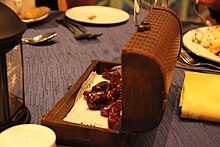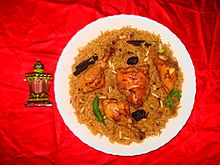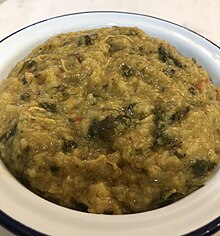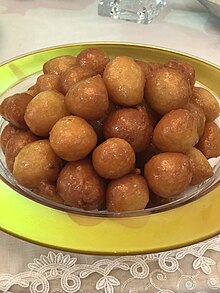Qatari cuisine
| Part of a series on the |
| Culture of Qatar |
|---|
 |
| History |
| Languages |
| Cuisine |
| Religion |
| Music and performing arts |
| Sport |
Qatari cuisine is made up of traditional Arab cuisine.[1] Machbūs, a meal consisting of rice, meat, and vegetables, is the national dish in Qatar, typically made with either lamb or chicken and slow-cooked to give it a depth of flavour.[2][1] Seafood and dates are staple food items in the country.[3] Many of these dishes are also used in other countries in the region because they share many commonalities. In other parts of the region, some of the dishes have different names or use slightly different ingredients.[4] One proponent of the importance of Qatar's culinary heritage is chef Noor Al Mazroei, who adapts traditional recipes to include vegan and gluten-free alternatives.[5]
Culinary traditions
[edit]Being invited to dine in a Qatari home is considered a special honor, reflecting the cultural value placed on hospitality. One notable aspect of Arab society is the generosity of the host, who typically prepares food in quantities much larger than necessary, ensuring that guests are abundantly provided for. To run out of food would be seen as a significant failure on the part of the host. Traditional meals are usually served with guests seated on the floor, partaking of the food with their hands, a custom that emphasizes closeness and communal sharing.[6]
Before the meal commences, it is customary to serve coffee or tea. Arabic coffee, brewed in brass coffee pots infused with cardamom, offers a distinctive aroma and flavor beloved by locals and visitors alike. Served in small porcelain cups, guests often consume three to five cups, signaling their satisfaction by gently shaking the cup when they have had their fill. Hot tea, typically flavored with mint and sweetened with sugar, may also be served in small glass mugs. Both coffee and tea are commonly offered not only in social settings but also in business meetings, reflecting the importance of hospitality in Qatari culture.[6]
Restaurants traditionally serving Qatari and Arabic food are called matbakhs (kitchen).[7] Such restaurants can be found almost all over Qatar, with notable concentrations being in Souq Waqif, The Pearl-Qatar and the Doha Corniche area.[8]
Dates and date syrup
[edit]
Dates (kholas) hold significant cultural and culinary importance as the national fruit of Qatar. Dates are widely cultivated in Qatar, with production exceeding 30,000 tonnes annually as of 2022, resulting in an 88% self-sufficiency in dates. This cultivation tradition dates back thousands of years and is deeply ingrained in the region's agricultural heritage. The Qatari national emblem features two date palms alongside a traditional dhow, symbolizing the country's relationship with this fruit. Beyond their cultural significance, dates play a vital role in Islamic tradition, particularly during Ramadan.[9]
They are celebrated annually during the local dates festival. The annual Local Dates Festival held in Souq Waqif provides a platform for local farmers to showcase their harvests and date-based products, contributing to the promotion of local agriculture. They are commonly offered as a symbol of hospitality in traditional Qatari gatherings, alongside Arabic coffee.[9] Several varieties of dates exist, among which the most popular in Qatar are khalas and shaishi.[10]
The manufacturing of date syrup is one of the oldest industries in Qatar, dating back to at least the 17th century. The syrup was obtained by using a traditional date press called madabis or madbasa. Due to its high-calorie content and nutrient density, it was a cheap and quick source of energy for the locals, particularly pearl divers.[11] With a short harvesting season for dates, the production of date syrup allowed for their preservation and prolonged consumption. This syrup served both civil and commercial purposes, being traded as a commodity and providing sustenance during periods of tribal conflicts and unrest. While modernization and lifestyle changes initially led to a decline in date syrup consumption, recent trends toward health-conscious alternatives have sparked renewed interest in this traditional sweetener.[12]
Ramadan culinary traditions
[edit]Preceding the commencement of fasting during Ramadan, Qataris engage in preparatory rituals and communal gatherings, exemplified by the observance of Sha'ban, the month prior to Ramadan, with al naflah festivities. During al naflah, families share traditional meals such as harees and tharid—a meal combining crumbled bread, meat, and broth— with neighbors and the less fortunate.[13]
Al Ghabqa is a feast that takes place at night during Ramadan following iftar and tarawih prayers, traditionally shared between immediate family members. The feast features a variety of dishes, notably grilled and fried fish, rice cooked with date extract, and tharid. The feat also includes an assortment of sweets such as luqaimat and asida, alongside dates, tea, and Arabic coffee.[14]
Since the 20th century, street food, particularly street kebabs, has been especially popular during Ramadan.[15]
Ingredients
[edit]Qatari cuisine predominantly revolves around staples like meat, fish, and rice, infused by a diverse array of spices, including but not limited to cumin, coriander, cinnamon, and saffron, aimed at enhancing flavor profiles. Furthermore, the incorporation of fresh ingredients such as herbs, vegetables, and fruits, whether locally sourced from regional markets or imported, is a ubiquitous feature. Oftentimes, Qataris will enhance popular traditional dishes by adding bread loaves or additional spices.[7]
Ingredients for traditional dishes can be purchased in local souqs (markets) such as Souq Waqif, which includes a spice souq.[7]
Qatari spice blends
[edit]
Spices play an important role in many dishes in Arabic cooking. Cooks will make sure to purchase the best-quality spices and avoid overbuying to preserve their freshness.[16]
Bizar
[edit]Bizar is a combination of black pepper, coriander seeds, cinnamon sticks, clove, dried ginger, whole cardamom, dried red chili, and turmeric sticks. The spices are first washed, and then sun-dried, after which they are ground and mixed.[4]
Daqoos blend
[edit]This is a red chili blend that includes roasted and crushed wheat, roasted and crushed cumin seeds, roasted and crushed sesame seeds, coriander seeds, crushed and dry red chili, garlic cloves, and finally salt.[4]
Hisso
[edit]This blend of spices includes dried ginger, cinnamon sticks, cardamom seeds, whole black pepper, turmeric sticks, and cumin seeds.[4]
Main dishes
[edit]
Qatari machbous
[edit]Machbous is the national dish of Qatar and consists of rice, meat, onions, and tomatoes mixed with spices, traditionally the bizar spice mix. Garlic, ginger, parsley and hot peppers may also be added.[17] This dish is the local variation of kabsa. It is similar to biryani or pulao.
Ghuzi
[edit]Ghuzi is a whole roast lamb served over nutty rice.[18] It is also called shuwaa.
Madrouba
[edit]
Madrouba is a spicy and comforting Qatari porridge made with chicken, overcooked rice, and a plethora of flavorings such as turmeric, cumin, cardamom, ginger, cloves, cinnamon, garlic, and black pepper. It is recommended to serve madrouba while it is still piping hot, preferably garnished with fresh lime zest.[19]
Harees
[edit]Harees is a dish made from grinding wheat seeds and mixing it with the fat (ghee). Salt and water are added, and it can be prepared with chicken or meat.[4]
Jareesh
[edit]Jareesh is a chopped chicken dish consisting of ghee, wheat and onions, and topped with onions and green peppers.[20]
Khobes rgag
[edit]Khobes rgag is a thin flatbread that is made of flour, water, and salt, and is also used in other dishes like thareed.[4]
Thareed
[edit]Thareed is a mixture of khobes rgag and broth, vegetables, and either chicken or meat.[4]
Saloona
[edit]Saloona is made of any broth with the meat and vegetables of your choice with spices.[21]
Desserts
[edit]

Luqaimat
[edit]Luqaimat is a is a dessert made of leavened and deep fried dough balls. The ingredients used to create this sweet pastry are flour, milk, butter, sugar, saffron, and cardamom. After being fried and ready to be served, honey or a sweet syrup is poured on top of it.[4]
Khabees
[edit]Khabees are seedless dates soaked in water, combined with roasted flour, and mixed with sugar, oil, butter, saffron, cardamom and rose water.[4]
Asida
[edit]Asida is a sweet dish made with flour, oil, and sugar.[4]
Balaleet
[edit]Balaleet are noodles cooked with sugar, cinnamon, saffron, and cardamom. There is often an omelette on top.[4]
Sago
[edit]Sago is a Qatari sweet gelatin pudding spiced with saffron and cardamom.[4] It can be found in Saudi Arabia and the United Arab Emirates too. [22]
Umm Ali
[edit]Umm Ali is bread and rice pudding.[23] Although this dish originates in Egypt, the Qatari version deviates slightly from it.[7]
Al-Qars Al-Uqaili
[edit]Al-Qars Al-Uqaili is a popular dessert in Qatari cuisine.[24] Known for its delicate texture, it is made from a thin dough that is cooked until it reaches a golden brown hue. The dough is then sliced into circular pieces.[25]
Drinks
[edit]Arabic coffee
[edit]Traditionally paired with dates, coffee is deeply entrenched in Qatari culture, reflects centuries of tradition and globalization. Originating from either Ethiopia or Yemen and later popularized in the Arab world, Arabic coffee, or gahwa, is among the most popular beverages in Qatar.[26] The preparation and consumption of Arabic coffee are steeped in rituals, with the brewing process and serving customs passed down through generations. In Qatari households, the making of Arabic coffee is considered a serious affair, often involving the use of high-quality green coffee beans, saffron, cardamom, cloves, and other traditional ingredients. These ingredients are carefully selected and sometimes ground by hand, reflecting the meticulous attention to detail in crafting the perfect cup of gahwa.[27]
In modern Qatari society, the tradition of Arabic coffee remains vibrant, with majlises serving as contemporary hubs for socializing and discussion, reminiscent of historical coffeehouses. While traditional Arabic coffee remains paramount in Qatari culture, younger generations have embraced a diverse coffee culture, leading to the proliferation of specialty coffee shops in Doha. These establishments offer a range of innovative brews and blends, catering to a diverse array of tastes and preferences.[26]
Karak
[edit]Karak, also known as "tea with milk" or "chai milk",[28] is a bright orange mixture with cardamom, saffron, and sugar.[18] Consisting of tea simmered with a mixture of spices along with evaporated milk, karak, while being popular, is not as widespread among the locals as gahwa (Arabic coffee).[6]
References
[edit]- ^ a b "The 3 M's of Qatari Cuisine". The Daily Meal. 3 October 2012. Retrieved 15 May 2015.
- ^ "Best Qatari Foods and Where to Find Them in Doha".
- ^ "Culture of Qatar". Hilal Plaza. Retrieved 6 May 2015.
- ^ a b c d e f g h i j k l Almeer, Sheikha Ahmad (2016). The Art of Qatari Cuisine. Doha: Gulf Publishing and Printing Co.
- ^ Al-Derbesti, Lamya (2021-06-04). "A Culinary Coincidence". Medium. Retrieved 2022-10-05.
- ^ a b c Augustin, Byron; Augustin, Rebecca A. (1 January 1997). Qatar. Enchantment of the World Second Series. New York: Children's Press. pp. 92–93.
- ^ a b c d Ataullah, Sanaullah (27 September 2023). "Qatari traditional cuisines, a true mélange of flavours". The Peninsula Qatar. Retrieved 30 April 2024.
- ^ Nabeela (27 December 2021). "Places in Qatar where you'll find authentic Qatari Food". iloveqatar.net. Retrieved 30 April 2024.
- ^ a b "Delicious dates of Qatar". Visit Qatar. Retrieved 28 April 2024.
- ^ "Qatar & Dates". Al Rayyan Agriculture. Retrieved 28 April 2024.
- ^ "Traditional Qatari Culture" (PDF). Qatar Tourism. p. 11. Retrieved 28 April 2024.
- ^ Al Maashani, Musllam; Menon, Lakshmi Venugopal (May 2023). "Traditional Date Presses (madabis) in Qatar" (PDF). Gulf Studies Centre of Qatar University. Retrieved 28 April 2024.
- ^ "Ramadan traditions in Qatar". Visit Qatar. Retrieved 29 April 2024.
- ^ Tawalbeh, Khalid (22 March 2024). "Ramadan customs and traditions an age-long heritage among Qataris". Qatar Tribune. Retrieved 6 June 2024.
- ^ "كباب الشوارع».. عادة رمضانية" (in Arabic). Al Raya. 28 April 1988. Retrieved 10 June 2024.
- ^ "Souq Wakif". 2 August 2017.
- ^ "Recipe: Celebrate Qatar's National Day with Machboos, Qatar's national dish". Epicurean Life. Retrieved 6 June 2024.
- ^ a b "Traditional Qatari Cuisine". Anglo info Limited.
- ^ "Madrouba | Traditional Porridge From Oman | TasteAtlas". www.tasteatlas.com.
- ^ "Qatar Airways introduces flavoursome Qatari meals onboard by Chef Aisha Al Tamimi". The Peninsula Qatar. 15 March 2023. Retrieved 6 June 2024.
- ^ Guglielmi, Stefania (2022-07-09). "Qatari Food: 15 Traditional Dishes You Must Try". Every Steph. Retrieved 2024-11-24.
- ^ "Sago Halawa | Traditional Pudding From Qatar | TasteAtlas". www.tasteatlas.com. Retrieved 2024-11-24.
- ^ "Qatar Food and Food Etiquette" Archived July 1, 2014, at the Wayback Machine. Qatar Visitor.
- ^ Awad, Samira (10 June 2023). "الشيف عائشة التميمي توثق الأكلات التراثية في كتابها "موائد شعبية قطرية"" (in Arabic). Al Jazeera. Retrieved 6 June 2024.
- ^ "Al-Qirq Al-Uqaili". Saqeefa Tea. Retrieved 6 June 2024.
- ^ a b "The culture of coffee in the Arab world". Visit Qatar. Retrieved 28 April 2024.
- ^ "The art of making Arabic coffee". Visit Qatar. Retrieved 28 April 2024.
- ^ "Getting to know Qatar". Qatar Friendship Fund. Retrieved 10 July 2015.
